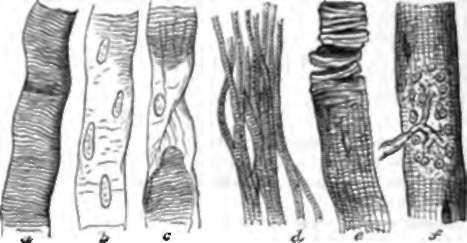Chapter IV. Muscles
Description
This section is from the book "Animal Physiology: The Structure And Functions Of The Human Body", by John Cleland. Also available from Amazon: Animal Physiology, the Structure and Functions of the Human Body.
Chapter IV. Muscles
29. The active element in which the force resides by which not only the bones and joints are set in motion, but likewise all the movements of the organs are accomplished, is called muscular fibre.
Muscular fibre presents two great varieties, the striped and the unstriped. The striped is the more complex, and, as it is the variety of which all the muscles consist, and over which the will has control, it is likewise termed voluntary muscular fibre; while the unstriped or smooth variety, being employed in the viscera, blood-vessels, and other structures subserving the purposes of organic life, and beyond the control of the will, is termed involuntary or organic muscular fibre. There are, however, various instances in which striped muscular fibre is not under the direction of the will, the principal being the heart; and there is a circumstance other than the relation to the will, on which more probably the kind of fibre used in each structure depends, namely, that striped muscle contracts suddenly when irritated, and becomes suddenly relaxed, whereas the unstriped contracts slowly and is relaxed slowly. The heart is required to contract rapidly, and striped muscular fibre is used in its construction. The mode of contraction of striped muscle is exemplified by the immediate response of the muscles of the skeleton to the impulses of the will; while the contraction of unstriped fibre may be seen by watching the enlargement and diminution of the pupil, occasioned by altering the focus of the eye or the amount of light admitted to it (p. 242). . But birds, which probably require more rapid action of the iris in connection with their extraordinary keenness of vision, have the muscular tissue of the iris composed of striped fibres; and in mammals the muscles of the tympanum, which are stimulated precisely in the same way as the iris, are of the striped description.

Fig. 30. Striped Mdscular Fibre, a, undisturbed fibre; b, treated with acetic acid, to show the nuclei; c, the striated substance torn and the sarcolemma uninjured; d, fibre teased out to show the fibrillę ; e, fibre broken into discs above, and showing fibrillar below; f, termination of nerve, after Kuhne.
Continue to:
